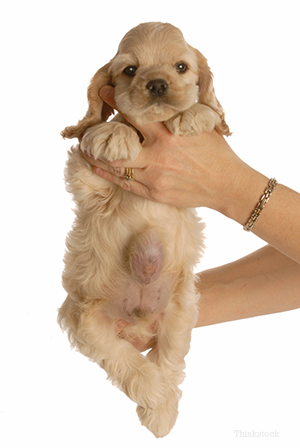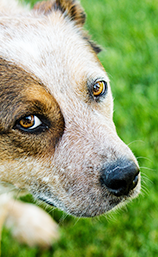Overview
Dogs can get hernias, just as people can. Dogs can be born with them, or they can be the result of an injury. A hernia is a tear in the wall of a muscle that allows the internal organs or fatty tissue normally found behind the muscles in the abdomen to push through.
There is good news and bad news when it comes to hernias. The bad news is, depending on the type, they can be life-threatening. The good news is that they are completely treatable!
There are five common types of hernias seen in dogs.
- Umbilical: This is the most common type of hernia. These are congenital and most commonly seen in puppies. If your pooch has an umbilical hernia, you will notice that her belly button has been replaced by a squishy protrusion. Depending on the size, these can either heal on their own or can be surgically fixed when your puppy is spayed or neutered. Failure to repair the hernia, if large enough, can lead to serious complications.
- Inguinal: These hernias occur in the “groin” area, where the inner fold of the rear leg attaches to the body wall. These can range in size from small to large, and—if the opening is large enough—portions of the intestine, the bladder, or the uterus can become trapped within the hernia, causing a life-threatening problem. This type is considered congenital and often affects middle-aged female dogs, especially those who are pregnant. These should be surgically fixed immediately to avoid complications.
- Diaphragmatic: The muscle that separates the abdominal organs from your dog’s heart and lungs is called the diaphragm.
 A hole in the diaphragm allows the internal organs to enter the chest cavity, making it difficult for your dog to breath. These hernias can either be congenital or the result of an injury; most commonly, being hit by a car.
A hole in the diaphragm allows the internal organs to enter the chest cavity, making it difficult for your dog to breath. These hernias can either be congenital or the result of an injury; most commonly, being hit by a car. - Perineal: When the muscles of the pelvis tear, abdominal contents enter the area adjacent to the anus. Some breeds are predisposed to this type of hernia, and it commonly occurs in unneutered male dogs over the age of 5. (Bottom line: Be sure to neuter your dog!)
- Hiatal: This type of hernia develops when a portion of the stomach pushes into the diaphragm, where the esophagus joins the stomach. Hiatal hernias can be congenital or the result of trauma.
Symptoms
Since a hernia pushes fat or internal organs through the muscles of the abdomen, the hernia often looks like a protruding, soft, bubble-like mass.
Additionally, your pet may have the following symptoms:
- Coughing
- Anorexia (not eating)
- Drooling
- Shortness of breath
- Vomiting
Diagnosis
Your veterinarian will tailor your dog’s treatment to the type of hernia suspected. In many situations, the hernia will be visible. In situations where the hernia is internal, your veterinarian might recommend an x-ray to evaluate your dog’s condition. In most situations, your veterinarian will recommend surgery to fix the hernia and appropriate medications/treatment, depending on the type of hernia and cause.
If your dog must undergo surgery to have the hernia repaired, your veterinarian may also recommend preanesthetic tests to ensure your dog is healthy and can tolerate the anesthetic procedure.
These may include:
- Chemistry tests to evaluate kidney, liver, and pancreatic function, as well as sugar levels
- A complete blood count to rule out blood-related conditions
- Electrolyte tests to ensure your dog isn’t dehydrated or suffering from an electrolyte imbalance
Prevention
There is no real way to prevent a hernia. Most hernias are either congenital or occur as a result of an injury or other health-related issue. Spaying or neutering your dog can have the greatest impact on preventing several types of hernias. Additionally, many hernia repairs can take place when your dog is spayed or neutered.
To learn more about the health benefits of having your dog spayed or neutered, or to learn more about hernias, please contact your veterinarian. They are the key resource for answers about the health and well-being of your best friend.
|
|
See more about conditions and causes of hernias in dogs Top Reasons to Spay or Neuter Your Dog How Much is Too Much Exercise? |

